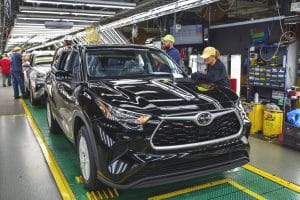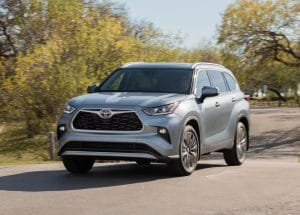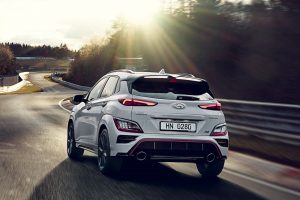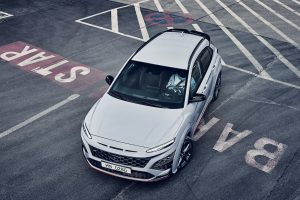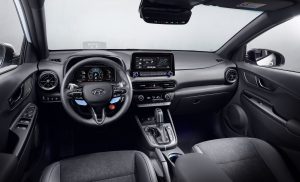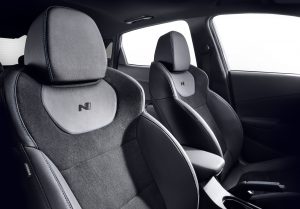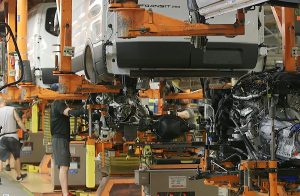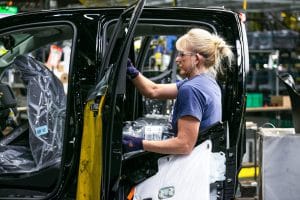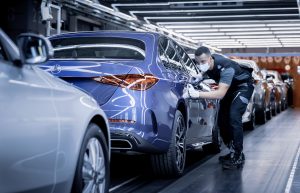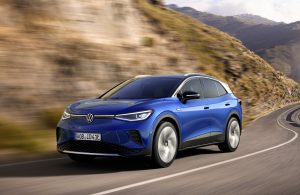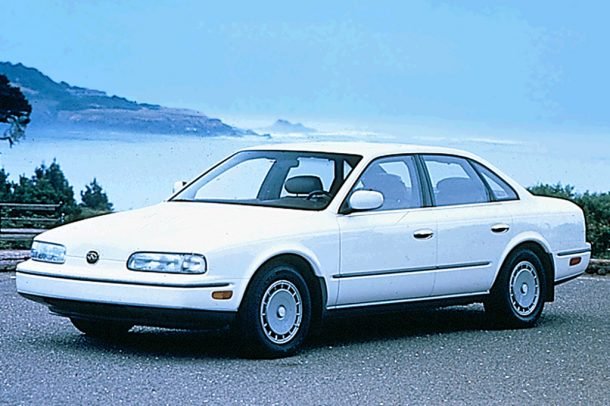 Late last year I put forth some thoughts about the future direction of Infiniti, largely about how the company was on a downward trajectory. Looking forward, the brand needs a major change in direction – not much has changed since December when I wrote that piece.
Late last year I put forth some thoughts about the future direction of Infiniti, largely about how the company was on a downward trajectory. Looking forward, the brand needs a major change in direction – not much has changed since December when I wrote that piece.
But one might then logically ask “Where did the company first lose its way?” I’m going to answer that question right now. Let’s take a little trip to the Before Times, in 1990.
That was the first model year for Infiniti just like it was the first model year for Lexus, but Infiniti started off on the wrong foot. I am of course speaking about the Q45, the grill-free, no-nonsense, no-wood, super-serious, full-size luxury sedan that was the company’s flagship. Where Lexus spent big money and years dreaming up an all-new car for its first U.S. luxury foray, Nissan went the cheap route. It took the upcoming new-generation President (the company’s JDM full-sizer) and then tried to Americanize it. Whereas Lexus made a more reliable Mercedes-Benz S-Class, Infiniti made a more hardcore BMW 7-Series without any of the iconic styling.
Americans wanted wood, ruched leather, a hood ornament, and a reasonably compliant suspension in their large sedans (they hate all that shit today, but whatever). Infiniti got a focus group together and then proceeded to edit the President into a firm-riding car without any wood or ruched leather. No grille, no hood ornament. After Judgment Error Number One was finished, they hired an ad agency to produce commercials for the exciting new Q45, and chose not to show it to customers. That’s right, they assumed that the luxury car buyer concerned with image and prestige would visit their dealer upon seeing an ad with a lake, rocks, and trees and “You can see this at a dealer!” tag line. That didn’t work then, and it wouldn’t work today. It was a terrible idea.
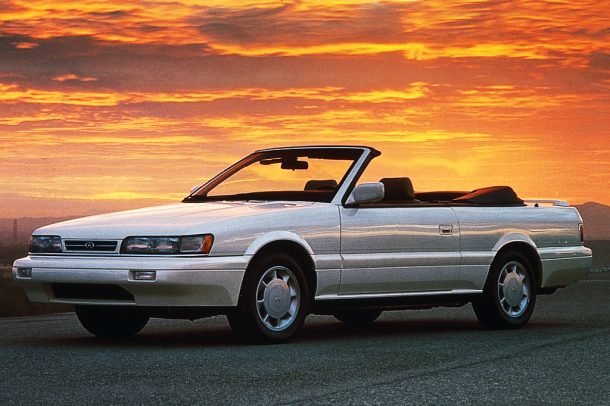 Their other premier offering was the M30 coupe and convertible. Based again on an existing Nissan, the Leopard, Infiniti went cheapo. Lexus spent big time money on the SC 400 and amortized that cost with the now-legendary Supra with which it shared a platform. The Leopard had some wood and leather added eventually (they’re learning!) and debuted as the M30. The Leopard wasn’t a bad car per se, and it had the V6 from the 300ZX. But it was again not what the American customer wanted. It was dated looking, too square, too small, not nice enough inside for the asking price, and half-assed. The SC and Acura Legend trounced it.
Their other premier offering was the M30 coupe and convertible. Based again on an existing Nissan, the Leopard, Infiniti went cheapo. Lexus spent big time money on the SC 400 and amortized that cost with the now-legendary Supra with which it shared a platform. The Leopard had some wood and leather added eventually (they’re learning!) and debuted as the M30. The Leopard wasn’t a bad car per se, and it had the V6 from the 300ZX. But it was again not what the American customer wanted. It was dated looking, too square, too small, not nice enough inside for the asking price, and half-assed. The SC and Acura Legend trounced it.
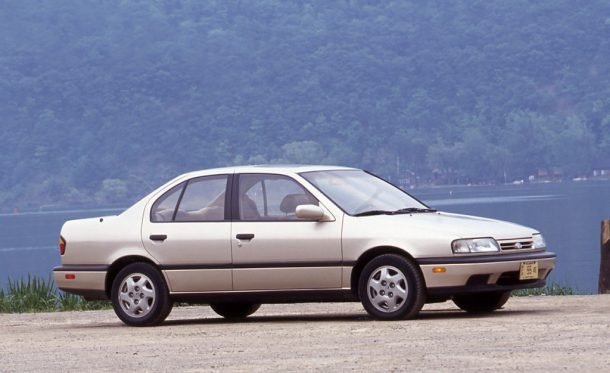 Shortly thereafter, Infiniti went after the Lexus ES 300 and the BMW 3-Series with the Nissan Primera-based G20. The Primera was more a world car than the President or Leopard, and more competitive generally. But G20 was a compact sedan with very bland styling, again based on something slightly too small for its American purpose. The ES 300 was larger and more luxurious and had interesting frameless windows. Most importantly, the ES didn’t look like it was a Camry. The G20 looked like a Sentra – which it wasn’t – but people assumed it anyway. People still think that even today in the age of the Internet. The G20 did make it quite a while (another problem) and earned itself a second generation that ran from 1999 to 2002. Infiniti had been around for nine years when the second G20 debuted, and the brand was still was doing badge swap jobs against unique Lexus product.
Shortly thereafter, Infiniti went after the Lexus ES 300 and the BMW 3-Series with the Nissan Primera-based G20. The Primera was more a world car than the President or Leopard, and more competitive generally. But G20 was a compact sedan with very bland styling, again based on something slightly too small for its American purpose. The ES 300 was larger and more luxurious and had interesting frameless windows. Most importantly, the ES didn’t look like it was a Camry. The G20 looked like a Sentra – which it wasn’t – but people assumed it anyway. People still think that even today in the age of the Internet. The G20 did make it quite a while (another problem) and earned itself a second generation that ran from 1999 to 2002. Infiniti had been around for nine years when the second G20 debuted, and the brand was still was doing badge swap jobs against unique Lexus product.
<img data-attachment-id="1617298" data-permalink="https://www.thetruthaboutcars.com/2018/03/buy-drive-burn-1995-buying-sports-luxury-sedan/attachment/97804011990406/" data-orig-file="http://ghostridermotorcycle.com/wp-content/uploads/2021/07/opinion-heres-where-infiniti-lost-its-way-29.jpg" data-orig-size="1024,682" data-comments-opened="1" data-image-meta="{"aperture":"0","credit":"","camera":"","caption":"","created_timestamp":"0","copyright":"","focal_length":"0","iso":"0","shutter_speed":"0","title":"","orientation":"1"}" data-image-title="1995 Infiniti J30t" data-image-description="
Image Infiniti
” data-medium-file=”http://ghostridermotorcycle.com/wp-content/uploads/2021/07/opinion-heres-where-infiniti-lost-its-way-26.jpg” data-large-file=”http://ghostridermotorcycle.com/wp-content/uploads/2021/07/opinion-heres-where-infiniti-lost-its-way-3.jpg” class=”aligncenter size-large wp-image-1617298″ src=”http://ghostridermotorcycle.com/wp-content/uploads/2021/07/opinion-heres-where-infiniti-lost-its-way-3.jpg” alt width=”610″ height=”406″ srcset=”http://ghostridermotorcycle.com/wp-content/uploads/2021/07/opinion-heres-where-infiniti-lost-its-way-3.jpg 610w, http://ghostridermotorcycle.com/wp-content/uploads/2021/07/opinion-heres-where-infiniti-lost-its-way-25.jpg 75w, http://ghostridermotorcycle.com/wp-content/uploads/2021/07/opinion-heres-where-infiniti-lost-its-way-26.jpg 450w, http://ghostridermotorcycle.com/wp-content/uploads/2021/07/opinion-heres-where-infiniti-lost-its-way-27.jpg 768w, http://ghostridermotorcycle.com/wp-content/uploads/2021/07/opinion-heres-where-infiniti-lost-its-way-28.jpg 120w, http://ghostridermotorcycle.com/wp-content/uploads/2021/07/opinion-heres-where-infiniti-lost-its-way-29.jpg 1024w” sizes=”(max-width: 610px) 100vw, 610px”>Don’t worry I didn’t forget the other Nineties flop they had, the midsize J30! Again with 300ZX power, the J30 was a slight rework of an updated Leopard, the Leopard J Ferie sedan. At least the J30 had unique looks, but they came at a price: Space. The midsize exterior of the J was not reflected in its interior, where it had space like a subcompact. The J was smaller than a contemporary Sentra inside because of its aggressive roofline and stubby trunk. The ingredients were there on this one: good engine, rear-drive platform, Poltrona Frau interior. But they misjudged the market again and delivered a car too small and too quirky looking for Americans. The rear end treatment is not dissimilar to a bustle-back Seville, really. And how’d that one go?
<img data-attachment-id="1670270" data-permalink="https://www.thetruthaboutcars.com/2019/04/qotd-your-least-favorite-rear-drive-nineties-ride/q45_pebble-beach/" data-orig-file="http://ghostridermotorcycle.com/wp-content/uploads/2021/07/opinion-heres-where-infiniti-lost-its-way-34.jpg" data-orig-size="800,518" data-comments-opened="1" data-image-meta="{"aperture":"0","credit":"","camera":"","caption":"","created_timestamp":"0","copyright":"","focal_length":"0","iso":"0","shutter_speed":"0","title":"","orientation":"0"}" data-image-title="1997 Infiniti Q45" data-image-description="
Infiniti
” data-medium-file=”http://ghostridermotorcycle.com/wp-content/uploads/2021/07/opinion-heres-where-infiniti-lost-its-way-31.jpg” data-large-file=”http://ghostridermotorcycle.com/wp-content/uploads/2021/07/opinion-heres-where-infiniti-lost-its-way-4.jpg” class=”aligncenter size-large wp-image-1670270″ src=”http://ghostridermotorcycle.com/wp-content/uploads/2021/07/opinion-heres-where-infiniti-lost-its-way-4.jpg” alt width=”610″ height=”395″ srcset=”http://ghostridermotorcycle.com/wp-content/uploads/2021/07/opinion-heres-where-infiniti-lost-its-way-4.jpg 610w, http://ghostridermotorcycle.com/wp-content/uploads/2021/07/opinion-heres-where-infiniti-lost-its-way-30.jpg 75w, http://ghostridermotorcycle.com/wp-content/uploads/2021/07/opinion-heres-where-infiniti-lost-its-way-31.jpg 450w, http://ghostridermotorcycle.com/wp-content/uploads/2021/07/opinion-heres-where-infiniti-lost-its-way-32.jpg 768w, http://ghostridermotorcycle.com/wp-content/uploads/2021/07/opinion-heres-where-infiniti-lost-its-way-33.jpg 120w, http://ghostridermotorcycle.com/wp-content/uploads/2021/07/opinion-heres-where-infiniti-lost-its-way-34.jpg 800w” sizes=”(max-width: 610px) 100vw, 610px”>This Nineties foundation started Infiniti off in the wrong direction, and the brand really never recovered. There was overcompensation in the opposite direction in the case of the second-gen Q45. It was a mushy, Buick-like car without a unique V8 (and was actually 4.1-liter). Gen-two Q was based on a smaller less prestigious car than the original Q. While Lexus was improving the LS 400 into the LS 430, Infiniti aimed downward and put forth a smaller car with a shorter wheelbase and a smaller engine. But it had lots of ruched leather and wood, at least. Your father might have considered one if he didn’t like the Park Avenue’s styling update in ’97.
 The company’s had two or three bright spots along the way, but they’ve never been able to replicate the success or mature it into a second-generation offering. The G35 was a sales success and brought back sporting credibility to Infiniti. Sedan, coupe, convertible, the G35 was the right product at the right time. It used Nissan’s FM platform that carried over into the G37 version, where things started to fall apart. It wasn’t as inspired as the G35, and overall less original. The VQ V6 problem was here too, among others: Each time Nissan made the VQ larger it lost some refinement, sounded more like a paint mixer, and got more thirsty (3.0, 3.5, 3.7, 4.0). G37 became Q50 and Q60, and that 20-year-old FM platform is still in use today. It’s a big problem that Nissan can’t seem to fix.
The company’s had two or three bright spots along the way, but they’ve never been able to replicate the success or mature it into a second-generation offering. The G35 was a sales success and brought back sporting credibility to Infiniti. Sedan, coupe, convertible, the G35 was the right product at the right time. It used Nissan’s FM platform that carried over into the G37 version, where things started to fall apart. It wasn’t as inspired as the G35, and overall less original. The VQ V6 problem was here too, among others: Each time Nissan made the VQ larger it lost some refinement, sounded more like a paint mixer, and got more thirsty (3.0, 3.5, 3.7, 4.0). G37 became Q50 and Q60, and that 20-year-old FM platform is still in use today. It’s a big problem that Nissan can’t seem to fix.
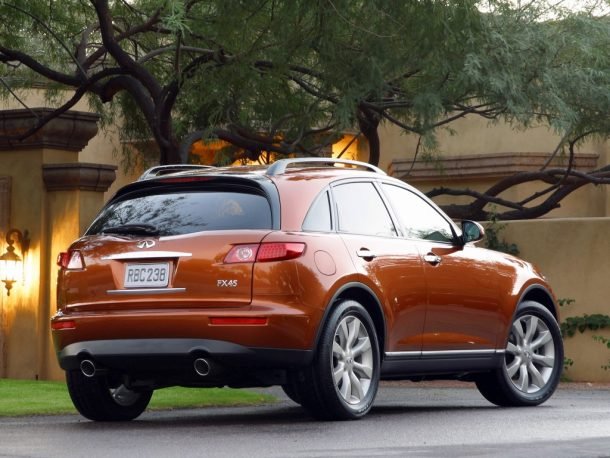 FM also became the FX35, a stylish and unique crossover way ahead of its time. But then it turned into the FX37 and started looking like a fish. There weren’t enough new ideas there, and people demanded more cargo room out of their midsize two-row SUV circa 2009. They’d be okay with crap cargo room now because that’s marketable as “coupe SUV,” which is bullshit, but it would’ve worked had the FX persisted today.
FM also became the FX35, a stylish and unique crossover way ahead of its time. But then it turned into the FX37 and started looking like a fish. There weren’t enough new ideas there, and people demanded more cargo room out of their midsize two-row SUV circa 2009. They’d be okay with crap cargo room now because that’s marketable as “coupe SUV,” which is bullshit, but it would’ve worked had the FX persisted today.
<img data-attachment-id="1618832" data-permalink="https://www.thetruthaboutcars.com/2018/03/qotd-whats-reliable-car-youve-ever-owned/attachment/96804051990203/" data-orig-file="http://ghostridermotorcycle.com/wp-content/uploads/2021/07/opinion-heres-where-infiniti-lost-its-way-50.jpg" data-orig-size="1024,682" data-comments-opened="1" data-image-meta="{"aperture":"0","credit":"","camera":"","caption":"","created_timestamp":"0","copyright":"","focal_length":"0","iso":"0","shutter_speed":"0","title":"","orientation":"1"}" data-image-title="1997 Infiniti I30" data-image-description="
Image Infiniti
” data-medium-file=”http://ghostridermotorcycle.com/wp-content/uploads/2021/07/opinion-heres-where-infiniti-lost-its-way-47.jpg” data-large-file=”http://ghostridermotorcycle.com/wp-content/uploads/2021/07/opinion-heres-where-infiniti-lost-its-way-7.jpg” class=”aligncenter size-large wp-image-1618832″ src=”http://ghostridermotorcycle.com/wp-content/uploads/2021/07/opinion-heres-where-infiniti-lost-its-way-7.jpg” alt=”Image: 1997 Infiniti I30″ width=”610″ height=”406″ srcset=”http://ghostridermotorcycle.com/wp-content/uploads/2021/07/opinion-heres-where-infiniti-lost-its-way-7.jpg 610w, http://ghostridermotorcycle.com/wp-content/uploads/2021/07/opinion-heres-where-infiniti-lost-its-way-46.jpg 75w, http://ghostridermotorcycle.com/wp-content/uploads/2021/07/opinion-heres-where-infiniti-lost-its-way-47.jpg 450w, http://ghostridermotorcycle.com/wp-content/uploads/2021/07/opinion-heres-where-infiniti-lost-its-way-48.jpg 768w, http://ghostridermotorcycle.com/wp-content/uploads/2021/07/opinion-heres-where-infiniti-lost-its-way-49.jpg 120w, http://ghostridermotorcycle.com/wp-content/uploads/2021/07/opinion-heres-where-infiniti-lost-its-way-50.jpg 1024w” sizes=”(max-width: 610px) 100vw, 610px”>Their third success was the I30 and subsequent I35, reworked Maximas which were different enough to work because the Maxima underneath them was decent enough at the time. Moderately luxurious, reliable, softer, and quieter than Maxima, attainably priced. The I30 especially was a nice car (if boring). The I35 suffered at the hands of cost-cutting in a big way but was still serviceable, and sold well. I35 lived on too long as Infiniti readied the G.
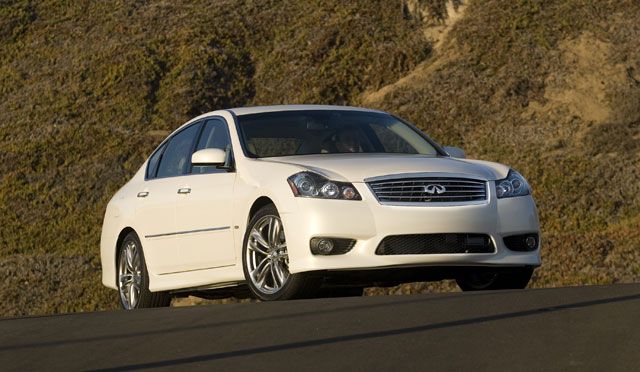 Oh, and there’s more FM: the M35. A larger midsize, M took over for the final Q45 as the only large-ish sedan the brand offered in 2007 (it shared the stage with Q for 2006). It was unrelated to the M45, a rebadged Nissan Gloria circa 2003 that was very enthusiast-approved but flopped with the general public given its looks. A generally successful offering, the M35 was not large enough to compete with full-size offerings from the other luxury brands and went against the E-Class, Lexus GS, and BMW 5-Series. The M had 2003-type styling at introduction in ’06 and maintained it through 2010 when everyone else had long moved forward. It was updated in 2011, again to add fish-like styling elements. It got larger in its rework (still not full-size), and spawned a long-wheelbase L version. It was renamed Q70 in short order but by then nobody cared. Stretched beyond its means, the FM Q70 did not feel well made, had an outdated interior full of 2006 components that were never updated, and was floppy in its handling while being too firm over bumps.
Oh, and there’s more FM: the M35. A larger midsize, M took over for the final Q45 as the only large-ish sedan the brand offered in 2007 (it shared the stage with Q for 2006). It was unrelated to the M45, a rebadged Nissan Gloria circa 2003 that was very enthusiast-approved but flopped with the general public given its looks. A generally successful offering, the M35 was not large enough to compete with full-size offerings from the other luxury brands and went against the E-Class, Lexus GS, and BMW 5-Series. The M had 2003-type styling at introduction in ’06 and maintained it through 2010 when everyone else had long moved forward. It was updated in 2011, again to add fish-like styling elements. It got larger in its rework (still not full-size), and spawned a long-wheelbase L version. It was renamed Q70 in short order but by then nobody cared. Stretched beyond its means, the FM Q70 did not feel well made, had an outdated interior full of 2006 components that were never updated, and was floppy in its handling while being too firm over bumps.
<img data-attachment-id="1436825" data-permalink="https://www.thetruthaboutcars.com/2016/10/consumer-reports-most-reliable-vehicles-mostly-unpopular/2016-infiniti-q70-premium-select-edition/" data-orig-file="https://www.thetruthaboutcars.com/wp-content/uploads/2016/10/2016-Infiniti-Q70-e1533069414239.jpg" data-orig-size="2928,1949" data-comments-opened="1" data-image-meta="{"aperture":"7.1","credit":"Infiniti","camera":"NIKON D4","caption":"The 2016 Infiniti Q70 Premium Select Edition's exterior offers dark chrome trim, a darkened lower rear bumper, a rear decklid spoiler and unique design and color 20-inch aluminum-alloy wheels with 245\/40R20 all-season performance tires. The interior of the Q70 Premium Select Edition is highlighted by unique Graphite or Stone semi-aniline leather seating, suede-like headliner, aluminum interior trim, illuminated kickplates and floor mats with contrasting piping.","created_timestamp":"1438974858","copyright":"\u00a9 2015 Infiniti","focal_length":"105","iso":"100","shutter_speed":"0.05","title":"2016 Infiniti Q70 Premium Select Edition","orientation":"1"}" data-image-title="2016 Infiniti Q70 Premium Select Edition" data-image-description="
Image: Infiniti
” data-medium-file=”https://www.thetruthaboutcars.com/wp-content/uploads/2016/10/2016-Infiniti-Q70-450×300.jpg” data-large-file=”http://ghostridermotorcycle.com/wp-content/uploads/2021/07/opinion-heres-where-infiniti-lost-its-way-9.jpg” class=”aligncenter size-large wp-image-1436825″ src=”http://ghostridermotorcycle.com/wp-content/uploads/2021/07/opinion-heres-where-infiniti-lost-its-way-9.jpg” alt width=”610″ height=”406″>I’ve gone on for a while here and now I’m worn out. In summation, bad foundational product lead to a poor start. The foundational product was bad because Nissan didn’t invest enough in Infiniti the way Toyota did with Lexus and to a lesser extent Honda did with unique product for Acura. The G37 should have been the last FM platform ever, yet Infiniti can’t seem to get away from it. Among their more recent problems, the subsistence on FM is the worst, most important, and most persistent. When are they gonna cut that cord?
[Images: Infiniti]
Related
 Today’s Rare Ride is the third car in the series from designer Franco Sbarro. Our premier Sbarro creation was a windsurfing-specific take on the Citroën Berlingo, and the second was a very hot hatchback called the Super Eight – a Ferrari underneath.
Today’s Rare Ride is the third car in the series from designer Franco Sbarro. Our premier Sbarro creation was a windsurfing-specific take on the Citroën Berlingo, and the second was a very hot hatchback called the Super Eight – a Ferrari underneath. The full-size SUV world of the late Seventies was very different than it is today, even though you’ll recognize all the names present. Trucks like the Toyota Land Cruiser, Mercedes-Benz G-Wagen, the Range Rover, and the International Harvester Scout were just that: Trucks. Their ornamentation was minimal, most of the time they were seen with only two doors, and sometimes a rear seat was optional. There wasn’t wood or leather, but one could find vinyl seating surfaces and minimal soundproofing. There was one exception to this rule, the luxurious Jeep Grand Wagoneer.
The full-size SUV world of the late Seventies was very different than it is today, even though you’ll recognize all the names present. Trucks like the Toyota Land Cruiser, Mercedes-Benz G-Wagen, the Range Rover, and the International Harvester Scout were just that: Trucks. Their ornamentation was minimal, most of the time they were seen with only two doors, and sometimes a rear seat was optional. There wasn’t wood or leather, but one could find vinyl seating surfaces and minimal soundproofing. There was one exception to this rule, the luxurious Jeep Grand Wagoneer. But a few visionaries at the time saw the potential for more luxurious off-road SUVs. We’ve covered one of the earliest examples of such a luxury truck previously: The Monteverdi Safari that went on sale in Switzerland in 1977. Based on the IH Scout II, the Safari beat Sbarro to the punch by just one year.
But a few visionaries at the time saw the potential for more luxurious off-road SUVs. We’ve covered one of the earliest examples of such a luxury truck previously: The Monteverdi Safari that went on sale in Switzerland in 1977. Based on the IH Scout II, the Safari beat Sbarro to the punch by just one year. The basis of the Windhound was the aforementioned G-Wagen, not a bad place to start. Using the G’s chassis, Sbarro designed an entirely different body up top. With its original design, the Windhound took things a step further than the clip swapping completed on the Safari. Windhound was available with either two or four doors, and sort of looked like an Eighties Toyota 4Runner. Four-door Windhounds were identified by their two rectangular headlamps, while two doors used quad circular lamps. A distinctive feature was the wrap-around roof spoiler above the rear hatch. This was supplemented in one example by exhaust pipes that ran up over the roof rails. All examples featured an interior full of wood and leather trim, and an unusual tailgate design with dual lower porthole windows. The Windhound was Sbarro’s second original design, as he’d spent the earlier part of the decade building replica cars (usually BMWs). His first original design was from 1974 and was a mid-engine Maserati-like sports car called the Stash, with an interior done by Pierre Cardin. We’ll cover that one later.
The basis of the Windhound was the aforementioned G-Wagen, not a bad place to start. Using the G’s chassis, Sbarro designed an entirely different body up top. With its original design, the Windhound took things a step further than the clip swapping completed on the Safari. Windhound was available with either two or four doors, and sort of looked like an Eighties Toyota 4Runner. Four-door Windhounds were identified by their two rectangular headlamps, while two doors used quad circular lamps. A distinctive feature was the wrap-around roof spoiler above the rear hatch. This was supplemented in one example by exhaust pipes that ran up over the roof rails. All examples featured an interior full of wood and leather trim, and an unusual tailgate design with dual lower porthole windows. The Windhound was Sbarro’s second original design, as he’d spent the earlier part of the decade building replica cars (usually BMWs). His first original design was from 1974 and was a mid-engine Maserati-like sports car called the Stash, with an interior done by Pierre Cardin. We’ll cover that one later. The Windhound was designed to be more powerful than other SUVs on offer, and as such used the 6.8-liter V8 from the 450SEL 6.9 as its primary motivation. The V8 was good for 282 horses and 410 lb-ft of torque, very impressive during the smog-choked Seventies. Typically the transmission paired to it was a three-speed automatic.
The Windhound was designed to be more powerful than other SUVs on offer, and as such used the 6.8-liter V8 from the 450SEL 6.9 as its primary motivation. The V8 was good for 282 horses and 410 lb-ft of torque, very impressive during the smog-choked Seventies. Typically the transmission paired to it was a three-speed automatic.








